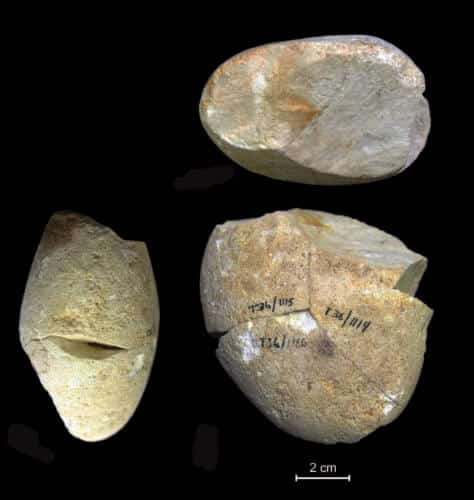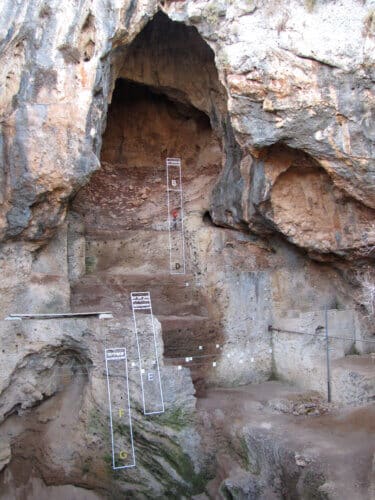Breakthrough technological changes: a view from 350,000 years ago
*The find, which was found in the Tabun Cave in Carmel by researchers of the University of Haifa, predates the findings that were known until now by about 150 thousand years*

A new study published in the Journal of Human Evolution by Dr. Ron Shimelmitz, Dr. Iris Gruman-Yaroslavsky, Prof. Mina Weinstein-Evron and Prof. Danny Rosenberg, from the Zinman Institute of Archeology at the University of Haifa, identified the earliest tool Until now, which was used for grinding different materials about 350 thousand years ago, even before the appearance of Homo sapiens. The tool, a rounded dolomite pebble with microscopic wear marks on it, was found in the Tabun Cave in Carmel - one of the flagship sites of prehistory in Israel and the world - and it predates any other tool in the world that bears evidence of wear by about 150 thousand years. "The extraordinary discovery from Tabun Cave shows that hominins processed different materials by grinding them already about 350 thousand years ago, that is, already at such an early stage a very significant technology was added to their 'toolbox' which teaches us that they could and wanted to process different materials in a variety of ways to improve and to maximize the ways in which they utilized the environmental resources" said the researchers.
Tabon Cave, part of the complex of sites that make up the UNESCO World Heritage Site in Nahal Merat in Carmel, is a unique site where a sequence of archaeological layers that testify to the activity of hominins (human species, including primitive human species) in the last half million years has been uncovered and has been used as a site for about 90 years A key to the study of human evolution.
The unique find was revealed as part of a new project led by Dr. Shimelmitz, together with Prof. Mina Weinstein-Evron and other partners in Israel and abroad, in which findings from past excavations at the site are re-examined (the research is supported by the National Science Foundation, the Gerda Henkel Foundation and the Dan David Foundation). While scanning the findings that were uncovered in the excavations conducted in the cave by Prof. Arthur Jelink from the University of Arizona in the late 60s and had not yet been studied and published, Dr. Shimelmitz noticed that one of the stones showed clear wear marks, which are known from much later stone tools, but not from ancient tools, which he discovered hundreds of thousands of years.
A careful study of the item in the laboratories of the Zinman Institute of Archeology allowed a systematic characterization of the weathering and the signs of use on its surface. The research carried out together with Prof. Danny Rosenberg, head of the laboratory for the study of stone tools and ancient food processing technologies and Dr. Iris Gruman-Yaroslavsky, head of the laboratory for the study of signs of use, focused on a microscopic analysis of the robe. The results of the research showed that the robe does bear characteristic marks indicating that the ancient tool was operated in a horizontal movement - from side to side, that is, in a grinding movement.

In order to understand and interpret the patterns they identified under the microscope, the researchers conducted a series of controlled erosion experiments using dolomite pebbles collected in Carmel and similar in their characteristics to pebbles from Tabun Cave. As part of these experiments, different materials were eroded over different periods of time with the help of the pebbles, which were immediately subjected to a microscopic examination, in which the erosion patterns created in the experiments were recorded. "While the results did not show a perfect match between the abrasion patterns recorded on the unique robe and those we recorded in the experimental research we conducted, we found a great similarity to the abrasion marks obtained as a result of the abrasion of the animal skins and from this we concluded that the ancient stone was used to abrade soft materials, although we do not yet know which Exactly," said Dr. Gruman-Yaroslavsky.
"While the tool is seemingly 'simple', its early appearance and the fact that it has no parallels at such an early stage of human evolution give it global importance," the researchers said. According to them, the early appearance of the erosion technology demonstrates the depth and complexity of the chain of technological innovations associated with human evolution. When did hominins start consuming food and other materials? Where did it happen? and why? These are some of the questions that preoccupy researchers of human evolution. "In fact, the evolution of the technology reflected in the stone tools directly reflects the patterns of change in the abilities of the ancient hominins to shape their environment," said Dr. Shimelmitz, adding, "the period of time 200-400 thousand years ago is a period of important technological innovations and significant changes in human behavior. For example, the use of fire becomes part of the daily routine, and the use of base sites from which various activities are carried out becomes a way of life. In this way, the erosion technology does not appear alone, but is integrated into a broader set of changes that foreshadows to some extent the complex behavior we know from the later hominins - the Neanderthals and Homo sapiens."
As mentioned, the next evidence of tools that were used for grinding were found only about 150 thousand years later. Was this ability lost until it was "found" again after so many years? "Although we have not been able to definitively link the item to food processing, there is a high probability that it was used for this purpose. Be that as it may, for those of us who deal with the archeology of food and its processing methods in the various periods, from prehistory to the present day, the small pebble from Tabun is of enormous importance, because it allows us to follow the earliest sources of the grinding action and how cognitive and motor abilities that developed during human evolution developed Finally, to important phenomena in human culture to this day, the beginning of which involves the erosion and development of food production techniques such as the transition to permanent settlement, agriculture, storage and, subsequently, the increase in social and economic complexity," Prof. Rosenberg concluded.
More of the topic in Hayadan:

One response
It is not possible to attribute any exhibit to a time that is before the creation of the world